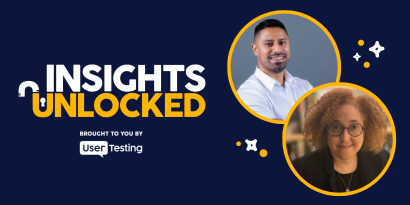
Episode 88 | August 21, 2023
Strategic internal UX research: fostering collaboration and innovation within your organization
In the episode, UserTesting’s Michael Mace delves into the world of internal research and organizational culture with Adrian Howard, an expert in building effective teams and products. Adrian's unique perspective on the intersection of product agility, UX, and strategy uncovers valuable insights into the power of internal research and its impact on company culture.
Strategic internal UX research: fostering collaboration and innovation within your organization
Candid feedback’s value rests upon the assurance that voices will remain anonymous and opinions valued.
Yet, internal research often grapples with the weight of power dynamics, where unvarnished truths can inadvertently create rifts.
“Honest answers can hurt people when those in positions of power do not like those answers,” said Adrian Howard in a recent interview on the Insights Unlocked podcast.
In the episode, UserTesting’s Michael Mace delves into the world of internal research and organizational culture with Adrian, an expert in building effective teams and products. Adrian's unique perspective on the intersection of product agility, UX, and strategy uncovers valuable insights into the power of internal research and its impact on company culture.
What is internal research?
In this context, internal research is that research done to gather, evaluate, measure and improve the employee experience. The employee experience (EX) is an all-encompassing term that represents the sentiments about an employee's (or potential employee’s) experiences with an employer or organization.
It covers such things as:
- Attraction
- Recruitment
- Onboarding
- Development
- Retention
- Separation
UserTesting’s talent team regularly uses the Human Insight Platform to collect candid feedback on job postings, internal communications and more. Other HR/people teams also have used the platform to improve their employee experiences. For example, watch the video below to see how Tucows used regular testing to improve their recruiting.

What are the challenges of internal research
The episode starts with a discussion on the challenges of internal research, where Adrian highlights the fear of identification as a major concern when employees participate in research. Honest feedback can sometimes hurt those in positions of power, leading to a lack of trust in the research process.
“It's almost the classic problem with research,” Adrian said. “It is just finding time and resources for it. It's just another chunk of time and resources and money that's being spent on a thing. And justifying that can sometimes be difficult.”
How to building trust and transparency with your internal research
Adrian suggests ways to mitigate these concerns, emphasizing the importance of anonymizing participant feedback and using ethical research practices. He also recommends involving participants in shaping how their feedback will be presented to the organization, fostering transparency and consent.

“I think the approach I more often take and prefer is to get the participants involved in the way that their feedback appears to the rest of the organization,” Adrian said. “You're getting explicit consent about this is the language that we'll use and the things that we will say to the rest of the organization and how we will phrase it.”
The benefit of behavior observation
The conversation shifts to observing behaviors within the organization. Adrian shares an example of a CEO's behavior during a design studio activity, revealing insights about power dynamics and their impact on decision-making.
The value of internal research
The episode delves into the benefits of applying research methodologies to internal processes. Adrian asserts that understanding internal teams, systems, and challenges is just as vital as understanding external customers. Research within the organization can lead to improved productivity, collaboration, and culture.
"When you comprehend your internal people and systems as well as you understand your external customers, you can achieve far more," Adrian said.
Why you should consider incremental research
Adrian suggests adopting an incremental approach to internal research, treating it as a background task rather than a separate project. This approach allows for continuous feedback and insights without overwhelming resources.
Mike describes it as micro research.
“When you hear the word research, people assume a huge project. I've got to do this big survey or something like that. Therefore, it has to be enormous. Therefore, I have to create a huge survey instrument. Therefore everybody has to review it. And you inevitably end up doing it only once a year,” he said.
Instead, he said. “There's no reason why you can't do a very short survey with a couple of questions. Or just do a user test, an experience research test, where you ask three or four people to respond to something. And then it's not it's not a big setup. You can do it really frequently. It's not a big pain in the neck to look at the results because you're only watching a couple of videos. And you can make it, if you think of it as feedback that you can do incrementally over time, that reduces some of the burden.”
Methodology considerations between quant and qual
The discussion touches on the balance between qualitative and quantitative research methods. While quantitative data is useful for evaluating solutions and systems, smaller scale qualitative approaches can provide valuable insights into behavior, fears, and motivations.
“"Qualitative insights offer deeper understanding of fears and motivations," Adrian said.
AI and ethical concerns
Adrian expresses skepticism about the current AI hype and its application in research. (Read about UserTesting’s vision for artificial intelligence).
“I guess in two words my thoughts are skeptical and grumpy,” he said. “We’re in peak hype mode for AI as a discipline right now, and AI unfortunately has a rather unhealthy history of overhyping and overselling its abilities, followed by a crash.”
He raises concerns about overselling AI capabilities and ethical, legal, and regulatory issues surrounding training data and model outputs. He recommends reading "On the dangers of stochastic parrots" paper, as well as following skeptical voices in the field to gain a more well-rounded perspective on AI and its implications.
Summary
Listen to the full episode to hear more of their conversation about the transformative potential of internal research in organizations. By addressing the fear of identification, fostering trust, observing behaviors, and utilizing an incremental approach, organizations can tap into valuable internal insights, leading to improved collaboration, innovation, and organizational culture.
Resources mentioned in the episode and where to learn more:
- Adrian’s newsletter and website: Quietstars.com
- The Center for Human Insight
- AI thought leaders: Emily Bender, Abeba Birhane, Timnit Gebru
- On the dangers of stochastic parrots;
- UserTesting’s 3 strategies for gathering inclusive employee feedback on HR programs










